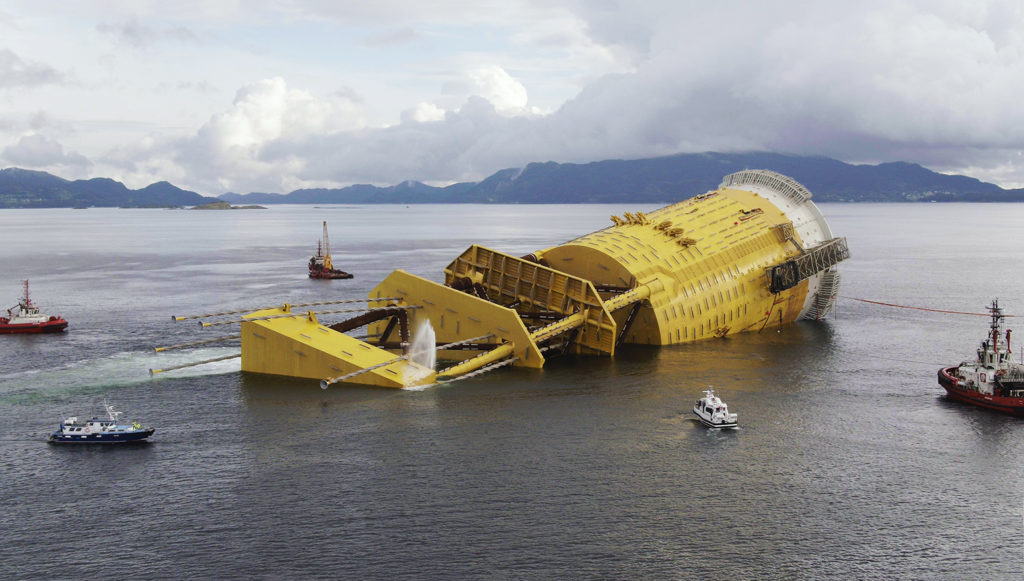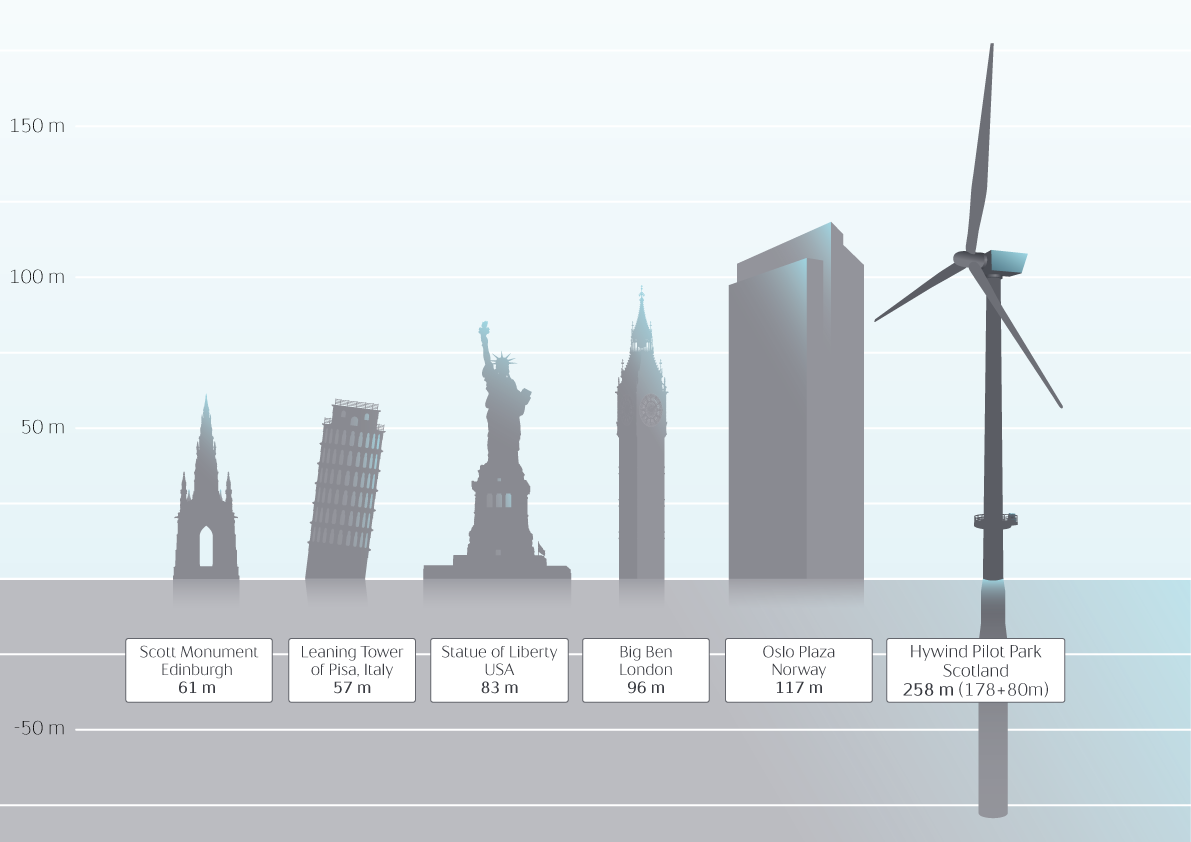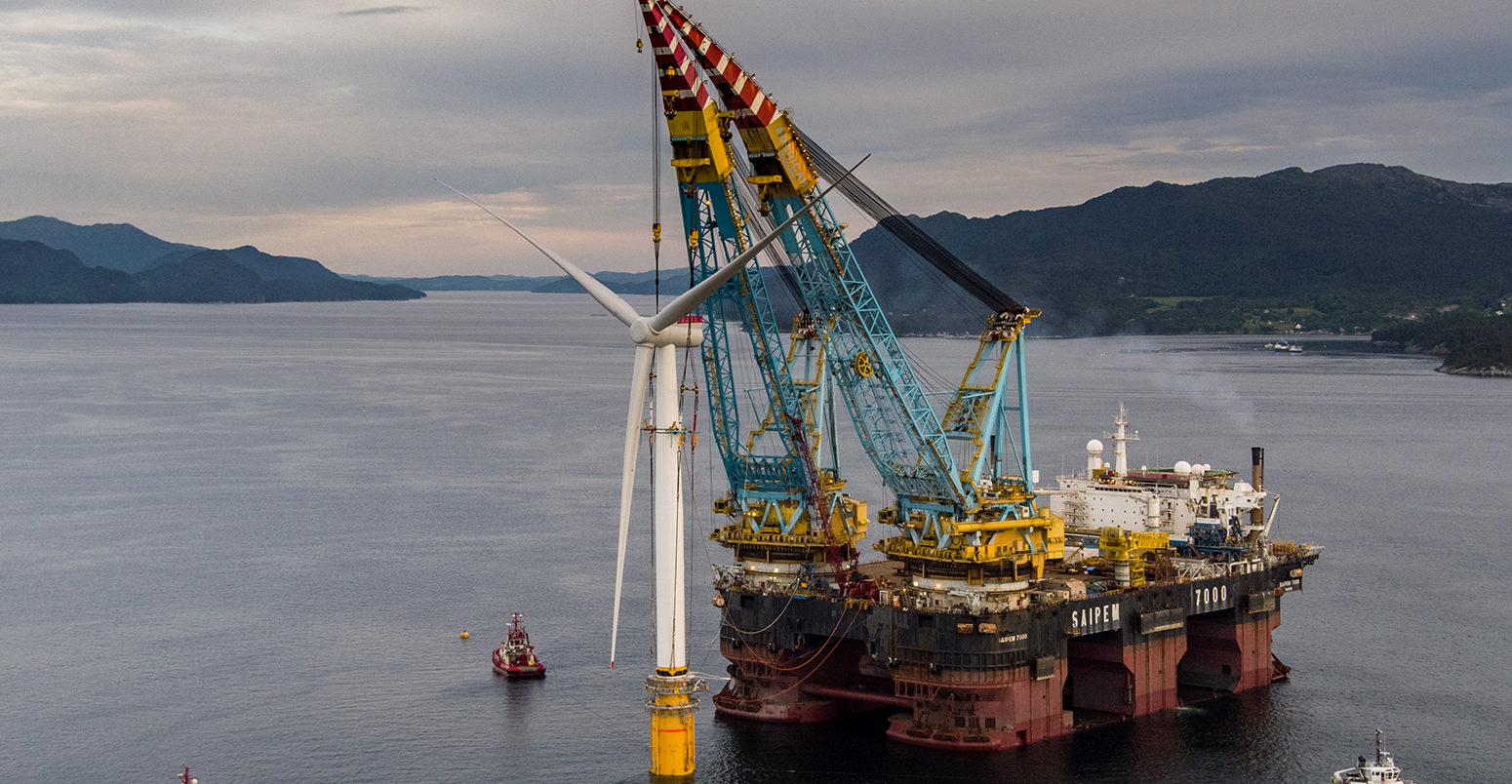
Q&A: How viable are floating offshore windfarms?
Jocelyn Timperley
07.27.17Earlier this week, it was widely reported that the world’s first floating windfarm is currently being installed off the coast of Peterhead in Scotland.
Statoil, which is developing the pilot Hywind windfarm, says the project aims to demonstrate the feasibility of future commercial, utility-scale floating windfarms.
Floating windfarms could have a number of advantages over conventional offshore windfarms. They can be placed in deeper waters where the wind is stronger and less variable. The turbines can be fully assembled close to shore before being towed out to sea and they could have less impact on wildlife than other types of wind turbine.
But with the technology still in its infancy and the costs relatively high, the question remains when, or if, they will be able to compete against fixed offshore wind turbines or other sources of energy.
Carbon Brief takes a look at the status of floating windfarms and their potential to provide renewable energy in the future.
(Update 18/10/2017: Hywind Scotland today started to deliver electricity to the grid, Statoil has announced. This makes it the world’s first floating windfarm to be connected to the grid.)
(Update 16/2/2018: Statoil yesterday announced Hywind Scotland had performed better than expected in its first three full months of production. The pilot project achieved an average capacity factor of 65% over these winter months. For comparison, the typical capacity factor for a typical offshore wind farm during the winter is 45-60%, according to Statoil. Statoil and its partner Masdar now have a target to reduce the costs of energy from the farm to €40-60/MWh (£36-53/MWh) by 2030.)
How do floating turbines work?
Just as oil and gas started with easier-to-access onshore developments, before moving to near offshore and, finally, to deeper locations, floating turbines represent a next phase in the location of wind turbines.
A floating wind turbine mounts a standard offshore model on a floating structure, rather than the fixed-bottom towers typically used for conventional offshore schemes. This allows floating windfarms to be located in depths far greater than the 50m-or-so limit of conventional offshore wind.
There are three dominant designs for floating wind structures: spar, tension leg platform (TLP), and semi-submersible, shown left to right in the image below.
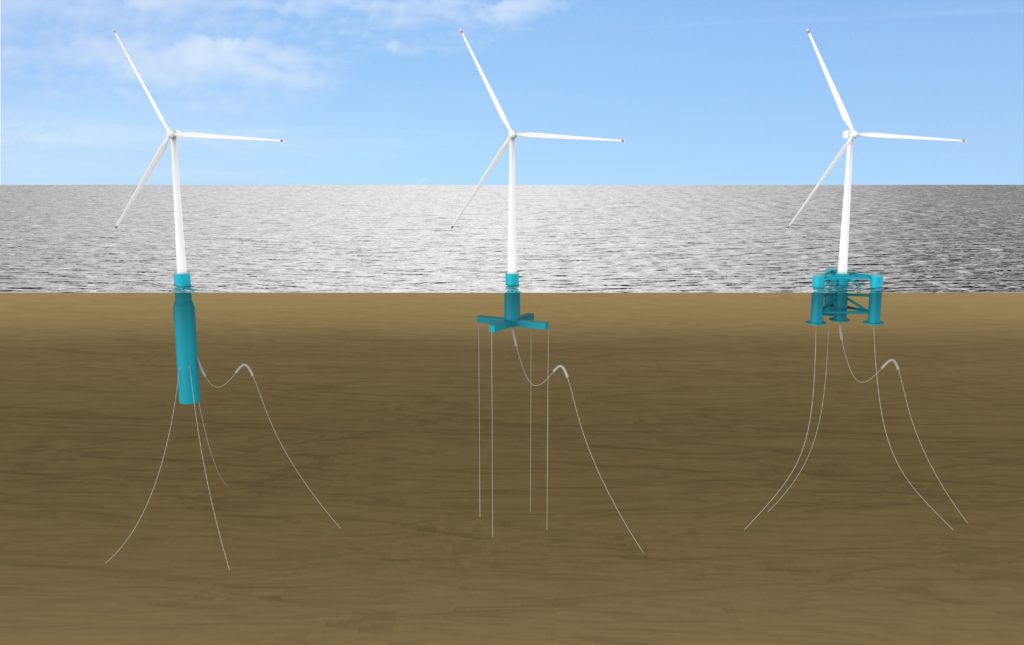
Spar, tension leg platform, and semi-submersible floating wind turbines. Image courtesy of ORE Catapult.
Each of these turbines gain their stability in different ways.
Spar-buoys rely on having the centre of gravity lower in the water than the centre of buoyancy. This is done by adding a heavy weight to the lower part of the structure.
Tension leg platforms – currently, the least advanced design – are anchored to the seabed and stabilised using tensioned mooring lines.
Semi-submersible platforms meanwhile are stabilised by buoyancy. They have 3-5 cylindrical platforms connected by tubes and float half submerged on the surface of the ocean whilst anchored to the seabed with mooring lines.
Rhodri James, a manager in Carbon Trust’s policy and innovation team, says these designs have been adapted from oil and gas technologies. He tells Carbon Brief:
“The key difference is that, whereas oil and gas consists of a small number of very large platforms, floating offshore wind requires a larger number of smaller platforms.”
(It’s worth noting the relative use of the word “small” here. The structures used for floating turbines still reach up to around 3,000 tonnes for steel designs and roughly 12,000 tonnes for concrete designs.)
The wind turbines used for floating windfarms are nearly identical to fixed-bottom structures.
What are the advantages of floating windfarms?
The promise of floating offshore wind turbines lies in their ability to be tethered in deep waters of 50-1,000 metres. These are not suitable for conventional fixed-turbine offshore wind structures, which are constrained to water depths of less than 50 or 60 metres because of the need to embed foundations in the sea floor.
Therefore, they open up areas of sea not previously suitable for offshore wind power, including areas where the continental shelf drops off too fast for fixed turbines to be viable, such as off the US west coast, Japan and, in this case, Aberdeen.
According to a 2015 review by the Carbon Trust, floating turbines could become increasingly important as the world exhausts the “low hanging fruit” of shallow near-shore sites and moves outwards from the coast.
The deeper waters where floating wind turbines can be located also have higher average wind speeds than closer to shore. This could lead to floating windfarms producing more electricity per gigawatt (GW) of installed capacity, increasing revenues. Higher capacity factors could also benefit onshore transmission networks by reducing variability.
They can also be almost completely put together close to shore before being towed out to their destination by simple, low-cost ships. This avoids the need to use expensive, heavy vessels to construct the wind turbines out at sea on top of permanent foundations.
The five turbines of the Scottish Hywind project, for instance, have been assembled in Norway and are in the process of being towed to the Scottish coast off Peterhead. This mobility could also be an advantage for heavy maintenance operations, where the turbines could be towed back to port.
Credit: StatoilFinally, their location further out to sea could offer a remedy for some public opposition to windfarms. Visually they would be even less prominent, while, according to RSPB, they could also be less harmful to birds than farms placed closer to the coast and, thus, seabird nesting sites.
In addition, they avoid the need to pile-drive a large foundation into the seabed, as well as lengthy offshore construction activity, both of which can be temporarily disruptive to sea life, including whales and birds.
Are there any disadvantages?
Aside from the cost due to being a nascent technology (see below), there are several technical challenges floating windfarms are faced with.
The floating nature of the turbines themselves could pose some problems. Bobbing of the turbine about on the water could reduce its capture of wind energy and risk damaging windmill components. However, this is not believed to be a major challenge since tools have been designed to mitigated it by making alterations to the turbine control system.
However, several bespoke elements will need to be developed before they are used at large scale. These include dynamic electrical cables, mooring and anchoring systems, and floating substations.
According to James, while these are not necessarily going to be “showstoppers”, they will still require further research and development before large scale deployment can be achieved.
How much will they cost?
As a young technology not yet commercially deployed, the costs of floating wind currently remain high. Early projects will need to be subsidised, meaning the rate of progression will depend to a large extent on political support. (It’s worth noting that the Hywind pilot is currently heavily subsidised by the Scottish government.)
If this support is given, costs are expected by several experts to fall in line with conventional offshore wind, as designs are optimised and the technology is deployed at scale.
A 2015 Energy Technologies Institute (ETI) report found that large-scale floating windfarms could deliver a levelised cost of electricity of around £85 per megawatt hour (MWh) by the mid 2020s.
The Carbon Trust study similarly concluded leading floating wind concepts could reach a levelised cost of electricity of £85-95/MWh in large-scale commercial projects in the 2020s, with further innovation potentially seeing costs fall still further.
For comparison, the Hinkley Point strike price was set at £92.50 MWh in 2012 prices, a figure that is index linked so will rise with inflation over its 35-year contract.
Meanwhile, in the UK’s 2015 Contracts for Difference (CfD) auction, offshore wind’s status as a “less established” technology meant it was granted the higher-than-average strike price of £117/MWh in 2012 prices, also index linked.
It’s worth noting that conventional offshore wind costs are also rapidly falling, however. A 2017 Dong Energy report found offshore wind projects in the UK fell to an average of £97/MWh during 2015-16. The results of the forthcoming auction for additional UK offshore wind capacity are widely expected to deliver costs below £85/MWh, beating a 2026 cost target set by the government by nine years.
James argues floating wind could be competitive with other energy technologies within the next decade if it is deployed at scale, particularly in markets with high energy demand in coastal areas with deep continental shelves.
Comparing conventional and floating windfarms, while the cost of the substructures for floating turbines – the spar buoy, for example – will likely remain higher than for fixed foundations, this may be negated to some extent by the advantages of floating windfarms listed above.
The IEA has said the cost of floating turbines today is the same as fixed-bottom ones a decade ago.
Any attempts to estimate the costs of future commercial projects will inevitably contain a great deal of uncertainty, since the technology is still in its infancy with few demonstrations actually in the water. Peter Stansby, professor of hydrodynamics at Manchester University, tells Carbon Brief:
“These figures are always quoted as improvements. It’s very hard – nobody I don’t think predicted that [the cost of] fixed structure, monopile offshore wind platforms would actually drop the way they have. So it’s like putting your finger in the wind.”
According to an article published last month by researchers from Offshore Renewable Energy Catapult in WindTECH International, once floating wind technology matures, the cost of substructures is the only area where cost or risk will lag materially behind monopiles.
How does Hywind work?
Statoil, the developers of the Hywind pilot project currently being installed off the coast of Peterhead, claims it is the world’s first commercial floating windfarm.
The 30 megawatt (MW) farm will be powered by five giant turbines made by Siemens Gamesa, distributed across around four square kilometres. These will be placed in an area of sea 25 km offshore from Peterhead with a depth of between 95 and 120 metres.
For now, just one of the turbines has been moved to Scotland, with the rest expected to be in place by the end of August. Generation is expected to begin later this year.
The 253m-tall turbines are of the spar-buoy design (see above), with 175m above the water and 78m below. According to a BBC article, Statoil claims the blades harness breakthrough software – which holds the tower upright by twisting the blades to dampen motions from wind, waves and currents.
The £190m pilot windfarm follows six years of testing by Statoil of a 2.3MW Hywind prototype installed off the island of Karmøy in Norway in 2009. During this time, Statoil’s design optimisation allowed it to tripled the power output of the turbine.
Statoil says the project aims to show cost efficiency and feasibility of multiple floating wind turbines in a region with optimal wind conditions, with its end goal being large scale floating offshore wind parks of 500-1,000MW. James says:
“Hywind Scotland is a major step forward to the industry as it will demonstrate the technology in an array layout for the first time (as opposed to the single prototype demonstrations to date). This will deliver important learnings in the construction and installation of multiple units and the interactions between turbines in a single windfarm.”
Hywind is subsidised under the UK’s Renewable Obligation Certificate (ROC) scheme, through which it will receive £160/MWh on top of the wholesale price of electricity (currently around £40/MWh). Statoil claims the costs of projects such as Hywind can be reduced by 40-50% by 2030. This could bring the cost down to around £100/MWh, similar to conventional offshore today. Given conventional offshore wind costs are also expected to fall, Statoil’s floating turbines would therefore remain more costly.
It’s worth noting that despite their generally favourable outlook on floating windfarms, the RSPB was opposed to the Hywind project as it is concerned that too many offshore turbines in the area have already been approved.
How many floating offshore projects are there?
Research and development into floating offshore wind turbines has been going on for around a decade, with a range of studies, prototypes and pilots tested in the UK and further afield.
According to the Carbon Trust, there are over 30 concepts currently under development, although only five have been demonstrated at full scale in an offshore environment.
US firm Principle Power installed a prototype of its WindFloat semi-submersible design in Portugal in 2011 and plans to mount pilots in Portugal in 2019 and France in 2020/21. SBM Offshore, meanwhile, aims to install a pilot farm of its tension-leg platform design in France in 2020/21.
Will we see floating wind turbines all over the sea?
While a nascent technology, floating offshore windfarms could open up areas of deeper sea not previously suitable for wind energy and show promise of some advantages over conventional offshore wind.
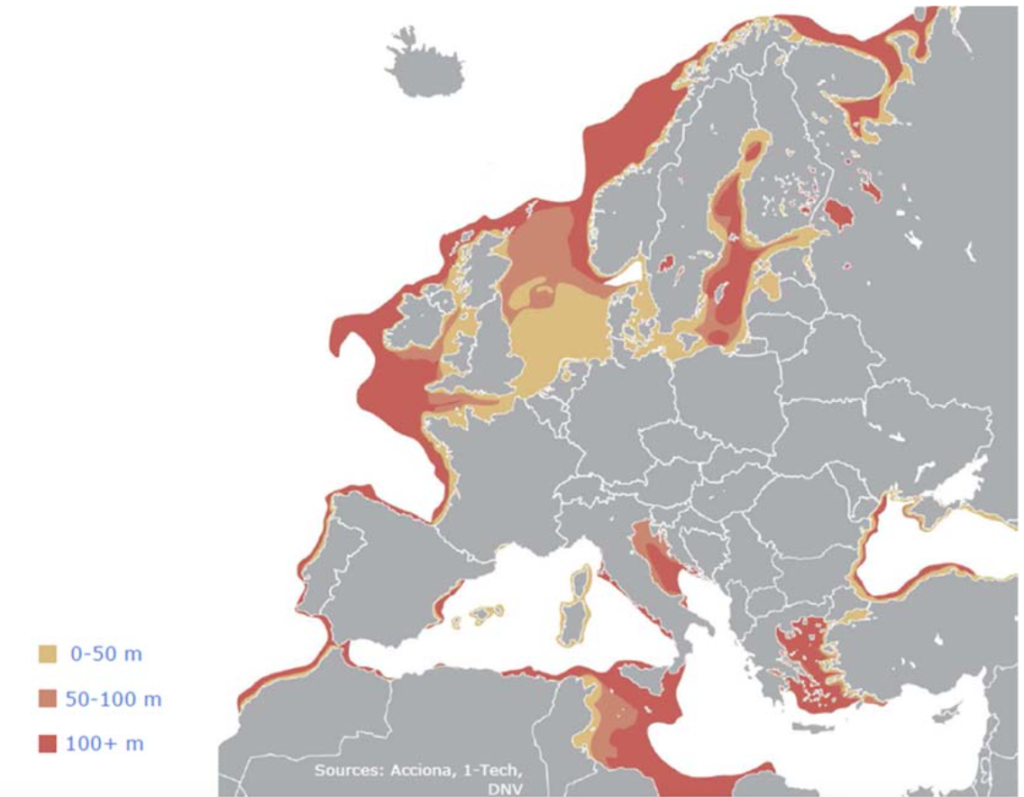
Sea depth around Europe. Source DNV-GL, 2014 via Carbon Trust, Floating Offshore Wind:Market and Technology Review 2015.
In 2013, the EWEA said the energy produced from turbines in deep waters in the North Sea alone could meet the EU’s electricity consumption four times over. (The variable output of wind means this would only be true across a full year, with other sources needed to fill in when the wind doesn’t blow).
Meanwhile, Scotland’s considerable natural wind resources, along with its well-developed supply chain and infrastructure developed for the offshore oil and gas sector, offer potential as a market for floating wind technology.
This could also open up further markets for the UK: another Carbon Trust paper, published in 2014, said Europe’s more developed offshore wind industry could be leveraged to speed up deployment in Japan, highlighting floating wind as a key area.
According to James, current market signals suggest that the first large-scale floating windfarms could be installed by 2025. This could pave the way for considerable growth over the coming decades, he says.
The development of floating wind could see wind power expanded to areas in the northern part of the North Sea, the Mediterranean and Atlantic coastlines of Western Europe, as well as locations outside Europe with deep continental shelves, such as parts of Japan, Taiwan, South Korea and the US.
This story was updated on 28/7/2017 to include the cost of the subsidy Hywind will receive under the ROC.
-
Q&A: How viable are floating offshore windfarms?
-
Blow by blow: Viability of floating offshore windfarms


